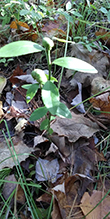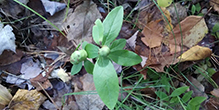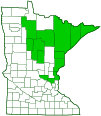blueberry stem gall wasp
(Hemadas nubilipennis)
Conservation • Description • Habitat • Ecology • Distribution • Taxonomy
|
|
||||||||||||||
Description |
Blueberry stem gall wasp is a tiny, gall-forming, chalcid wasp. It occurs in the United States and southern Canada east of the Great Plains. In Minnesota it is common in the northeast quarter of the state. Blueberry stem gall wasp forms a multi-chambered swelling (gall) on a highbush or lowbush blueberry stem. It is often found in wild blueberry populations. It has only recently become a significant pest of commercial blueberry crops. The female lays multiple eggs in a young stem. Most egg laying, about 70%, takes place low in the stem, within leaf litter near the ground. The remaining is higher on the stem. After laying eggs, the female climbs to the stem tip and stabs it several times. This causes severe damage and often causes the stem to stop growing. Before the eggs hatch, the plant forms a soft, red swelling composed of non-vascular (parenchymatous) cells. After the eggs hatch and the larvae begin to feed, stronger, fibrous (sclerenchymatous) cells form walls around each larval chamber. By mid-summer the gall is hard, woody, darker reddish green, kidney-shaped, and ¼″ to 1½″ (7 to 38 mm) long. The size is determined by the number of eggs in the gall. Most adults by far are female. They are 1⁄16″to ⅛″ (2 to 2.5 mm) in length. The head, thorax, and abdomen are black. The antennae are bent (elbowed) and have 10 segments. The first segment (scape) is long. The end segments are enlarged, creating a club at the tip. They are mostly orangish yellow, but the club is black. The rear part of the body (gaster) is coarsely sculptured. On the female, the needle-like egg-laying tube (ovipositor) is short. The forewings are long, reaching to the end of the abdomen. They are clear and lightly tinged with black. They have no closed cells. The veins reach more than halfway to the tip. The legs are orangish yellow. On the hind legs, the third segment (femur) is not swollen, and the fourth segment (tibia) is more or less straight. The last part of each leg (tarsus), corresponding to the foot, has 5 segments. |
Size |
Total length: 1⁄16″to ⅛″ (2 to 2.5 mm) |
Similar Species |
Habitat |
Highbush and lowbush blueberry |
Ecology |
Season |
One generation per year: |
Behavior |
Adults are active only in the day, and especially on warm days. |
Life Cycle |
The larvae feed in individual cells within the gall. They overwinter in the gall and pupate in the spring. Adults emerge from late May to early June before the host buds break. |
Larva Food |
Blueberry stem tissue |
Adult Food |
|
Distribution |
||
|
Sources |
|
| 7/21/2025 | ||
Occurrence |
||
Common |
||
Taxonomy |
|
Order |
Hymenoptera (Ants, Bees, Wasps, and Sawflies) |
Suborder |
Apocrita (narrow-waisted wasps, ants, and bees) |
Infraorder |
Proctotrupomorpha |
Superfamily |
Chalcidoidea (chalcidoid wasps) |
Family |
Ormyridae |
Subfamily |
Ormocerinae |
Genus |
Hemadas |
This is the only species in the genus Hemadas. |
|
Subordinate Taxa |
|
|
|
Synonyms |
|
Megorismus nubilipennis Parhabritys nubilipennis |
|
Common Names |
|
blueberry stem gall wasp |
|
Glossary
Femur
On insects and arachnids, the third, largest, most robust segment of the leg, coming immediately before the tibia. On humans, the thigh bone.
Gall
An abnormal growth on a plant produced in response to an insect larva, mite, bacteria, or fungus.
Gaster
The bulbous part of the abdomen of ants, bees, and wasps. In ants it usually begins at segment three.
Ovipositor
A tube-like organ near the end of the abdomen of many female insects, used to prepare a place for an egg and to place the egg.
Scape
In plants: An erect, leafless stalk growing from the rootstock and supporting a flower or a flower cluster. In insects: The basal segment of the antenna.
Tarsus
On insects, the last two to five subdivisions of the leg, attached to the tibia; the foot. On spiders, the last segment of the leg. Plural: tarsi.
Tibia
The fourth segment of an insect leg, after the femur and before the tarsus (foot). The fifth segment of a spider leg or palp. Plural: tibiae.
Visitor Photos |
||
Share your photo of this insect. |
||
This button not working for you? |
||
Luciearl |
||
 |
||
MinnesotaSeasons.com Photos |
||
|
||
|
||

Slideshows |
|

Visitor Videos |
||
Share your video of this insect. |
||
This button not working for you? |
||
|
Other Videos |
||
Blueberry gall wasps, Hemadas nubilipennis |
About
Sep 8, 2018 These tiny wasps (𝘏𝘦𝘮𝘢𝘥𝘢𝘴 𝘯𝘶𝘣𝘪𝘭𝘪𝘱𝘦𝘯𝘯𝘪𝘴) induce stem galls in blueberries (𝘝𝘢𝘤𝘤𝘪𝘯𝘪𝘶𝘮), where their larvae develop. From Dr. Patrick Edger, Department of Horticulture, Michigan State University. |
Emergence, blueberry stem gall wasp |
About
Nov 9, 2017 Adult blueberry stem gall wasp, Hemadas nubilipennis, chewing its way out of a gall on wild lowbush blueberry, vaccinium angustifolium 11 May 2017 Iowa, USA |

Created: 11/17/2023 Last Updated: © MinnesotaSeasons.com. All rights reserved. |



